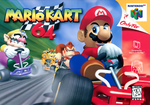Template:Featured: Difference between revisions
(Updated to Paper Mario) |
(Updated to Mario Kart 64) |
||
| Line 1: | Line 1: | ||
<noinclude>'''Please read:''' If you are going to replace the current information on the Featured template, please see [[Template:UpcomingFA|here]] before doing that and look at which order our next FAs will be put on this page. [[Category:Main page templates]]</noinclude>{{featured-image| | <noinclude>'''Please read:''' If you are going to replace the current information on the Featured template, please see [[Template:UpcomingFA|here]] before doing that and look at which order our next FAs will be put on this page. [[Category:Main page templates]]</noinclude>{{featured-image|MK64 Cover.png|150px}} | ||
''''' | '''''Mario Kart 64''''' is a [[Genre#Racing games|racing]] game that was originally released for the [[Nintendo 64]] in 1996 in Japan and 1997 worldwide. It is the second game in the ''[[Mario Kart (series)|Mario Kart]]'' series. Being an upgrade from its predecessor, ''[[Super Mario Kart]]'', it features a similar base to that game in which players select cast members of the [[Super Mario (franchise)|''Super Mario'' franchise]] to drive in [[kart]]s, employing a weapon-based system to benefit the player and hinder opponents, though it has expanded gameplay, such as the introduction of [[Mini-Turbo]] boosts from [[drift]]ing and four-player support. It is the first game of the ''Super Mario'' franchise to let more than two people play simultaneously. It is also the first ''Mario Kart'' game to use three-dimensional graphics for its environment design, such as the addition of elevation, advanced collision physics, expanded camera controls, real walls that can obscure views, and increased aesthetic fidelity; however, the characters, the items, and some track obstacles in-game remain as two-dimensional, pre-rendered sprites, which are rendered for game optimization. Additionally, the game contains unique track designs rather than multiple variants of the same track, and it introduces various track tropes that would later be reused in later ''Mario Kart'' installments, such as [[Luigi Circuit]] being the first track. Other elements would become series mainstays, such as its racer weight classification, the introduction of [[Wario]] and [[Donkey Kong]] as playable characters, and several new items such as the [[Spiny Shell (blue)|Spiny Shell]] and triple variants of [[Green Shell]]s and [[Red Shell]]s. {{more|Mario Kart 64}} | ||
Revision as of 08:42, October 7, 2023
Please read: If you are going to replace the current information on the Featured template, please see here before doing that and look at which order our next FAs will be put on this page.
Mario Kart 64 is a racing game that was originally released for the Nintendo 64 in 1996 in Japan and 1997 worldwide. It is the second game in the Mario Kart series. Being an upgrade from its predecessor, Super Mario Kart, it features a similar base to that game in which players select cast members of the Super Mario franchise to drive in karts, employing a weapon-based system to benefit the player and hinder opponents, though it has expanded gameplay, such as the introduction of Mini-Turbo boosts from drifting and four-player support. It is the first game of the Super Mario franchise to let more than two people play simultaneously. It is also the first Mario Kart game to use three-dimensional graphics for its environment design, such as the addition of elevation, advanced collision physics, expanded camera controls, real walls that can obscure views, and increased aesthetic fidelity; however, the characters, the items, and some track obstacles in-game remain as two-dimensional, pre-rendered sprites, which are rendered for game optimization. Additionally, the game contains unique track designs rather than multiple variants of the same track, and it introduces various track tropes that would later be reused in later Mario Kart installments, such as Luigi Circuit being the first track. Other elements would become series mainstays, such as its racer weight classification, the introduction of Wario and Donkey Kong as playable characters, and several new items such as the Spiny Shell and triple variants of Green Shells and Red Shells. Template:More
